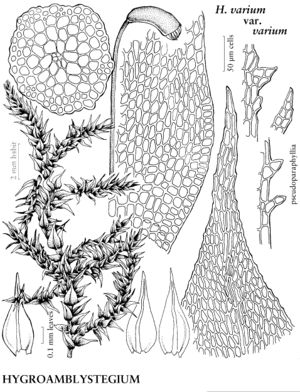Hygroamblystegium
Moosfl. Harz., 298. 1903.
| Taxon | Illustrator ⠉ | |
|---|---|---|
 | Hygroamblystegium varium var. varium | Patricia M. Eckel |
Plants small to large, yellow to dark green or blackish. Stems irregularly and often freely branched; hyalodermis absent, central strand usually present; paraphyllia often present, ± lanceolate; rhizoids on stem, never from abaxial costa surface, often forming tomentum, sparsely branched, smooth; axillary hairs well developed and many, or small, delicate, sparse, distal cells 1 or 2, hyaline. Stem and branch leaves erect, not or slightly falcate-secund, oblong-lanceolate to oblong-ovate, rarely broadly ovate, not plicate, to or longer than 1 mm; base not decurrent; margins plane, entire to denticulate, limbidia absent; apex gradually acuminate, acute, or obtuse, acumen plane or furrowed; costa single, ending mid leaf to excurrent, broad, often curved beyond mid leaf; alar cells not or poorly differentiated, rectangular to quadrate, not or slightly inflated, green to brownish orange, walls thin or slightly incrassate in mature leaves, region indistinct, ovate, along basal margins; medial laminal cells rhombic to oblong-hexagonal, (9–) 13–65 (–67) µm, smooth. Sexual condition autoicous. Capsule inclined, cylindric to oblong-cylindric, arcuate; peristome perfect; exostome teeth bordered; endostome cilia in groups of 1–3, nodulose to appendiculate. Spores 12–45 µm.
Distribution
North America, Mexico, Central America, South America, Eurasia, s Africa, Pacific Islands (New Zealand), Antarctica
Discussion
Species 1.
Hygroamblystegium is morphologically highly variable; conflicting taxonomic treatments arose from different interpretations of character significance. The species is mostly aquatic to subaquatic; a substantial proportion of the morphological variation is purely plastic. None of the species form monophyletic groups in molecular phylogenetic analyses. All exhibit various ploidy levels, and Hygroamblystegium can be compared to a complex of agamospermous vascular plants, where the wide range of genetic variability within apparent species of polyphyletic origin are retained in the face of fast and independent evolution of polyploid genomes, unlikely to be associated with any pattern of morphological variation. All species names previously recognized in the flora area are considered here as synonyms of H. varium. Some traits are indicative of habitat conditions. Although plants with convergent morphologies do not form monophyletic lineages and should thus not be given species status, their recognition at an infra-specific level is supported ecologically. These infra-specific taxa correspond to terrestrial plants of wet meadows, fens, and marshes (var. humile), and aquatic plants of oligotrophic, calcareous springs, which, owing to their endemic occurrence in North America, may be recognized at the subspecies level, namely subsp. noterophilum. Although phylogenetically unrelated, Hygroamblystegium sometimes bears strong resemblance to Cratoneuron filicinum (Hedwig) Spruce. The best example of this convergence has been called H. tenax var. spinifolium (Schimper) Jennings, a morphologically well-characterized taxon of large plants with long-excurrent, thick costae. Despite the lack of inflated, hyaline alar cells and the strictly straight leaves, this is an aquatic expression of C. filicinum in oligotrophic, calcareous spring areas.
Selected References
None.
Lower Taxa
"narrower" is not a number.